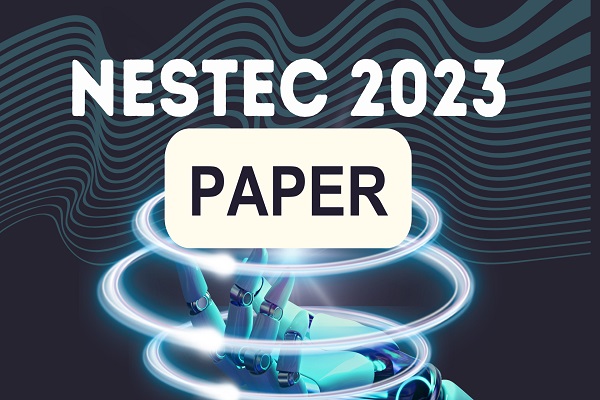ABSTRACT
In an era where urbanization accelerates relentlessly, the roads of our modern cities are with increasing congestion and inefficiency. As the world progresses, the need for intelligent solutions to untangle the knots of traffic has become an imperative echoed across metropolises. This paper, therefore, focuses on the design, implementation, and evaluation of a Smart Traffic Management System using the Internet of Things. Think about roads that could sense how many cars are on them, and therefore adjust the timings of traffic lights accordingly to balance traffic flow. By leveraging IoT and advanced traffic management techniques, this proposed Smart Traffic Management System holds the promise of revolutionizing urban mobility, fostering efficiency, sustainability, and livability in cities.
Keywords: IoT, Roads, Smart, Traffic system, Urban
Author: Abosede, Iyiola David
Supervising Lecturer: Dr D.A Dikko
Click the Link Below For Full Paper, Questions and make your COMMENTS
Design and Implementation of a Smart Traffic Management System Using IoT











This is well detailed for a creative way to manage our system in Nigeria. However, with the future of Artificial Intelligence (AI) on a IoT-based Smart Traffic Management System in the country, how can this intelligent system of managing our traffic enhance the manufacture and production of electric cars that would run on sustainable energy system on our roads in Nigeria. .
Thanks for this.
It is no gainsaying that the distance at which an electric car can travel is dependent on the level of power in the battery.
Therefore, unless the traffic moves so fast, the battery of an electric vehicle can drop dead at the middle of the road.
This paper proposes a smart-traffic management system that reduces the time of travel of vehicles on Nigerian roads. I believe this will enhance the manufacture of electric vehicles and other cars that are primarily designed to be fast.
The abstract is well written and goes straight to the point. I am impressed by the author’s writing skills.
Thank you.
The author’s writing skills are impressive; the abstract is succinct and to the point.
Thank you.
The author’s writing skills are commendable; the abstract is concise and focused.
Please, don’t hesitate to ask your questions.
Thank you.
The write up is an informative and educative write up. How I wish this could be implemented in our beloved nation to ease traffic congestion in our cities.
Great work 👍💯
Thanks for your kind words!
I share your hope that this solution is implemented to ease traffic stress in Nigeria.
This is great. Kudos to the author.
Beyond the smart management of traffic, what are the potential economic and societal impacts of implementing your system?
Thank you.
Beyond the smart control of traffic, the system, through decreased traffic congestion contributes to lower greenhouse gas emissions by vehicles and improved air quality, thereby reducing healthcare costs associated with air pollution.
Also, reduced travel times allow individuals to spend more time on productive work and less time stuck in traffic. Furthermore, efficient traffic flow can attract businesses and investments in the region, leading to economic growth.
Your work is so thoughtful and well done,
Excellent job on this project,
It an impressive work.
Thanks for your kind comment.✨
Great work and solution. Indeed, with the ever increasing population in Nigeria, there is no better time than now for the country to set up IoT-based smart traffic management system to mitigate road congestion and foster traffic flow; thus improving the quality of life in the nation.
Indeed, there is no better time than now.
I’m glad you found it worth-implementing.
Thanks.
Great work and solution. Indeed, with the ever increasing population in Nigeria, there is no better time than now for the country to set up IoT-based smart traffic management system to mitigate road congestion and foster traffic flow; thus improving the quality of life in the nation.
Indeed, there is no better time than now.
I’m glad you found it worth-implementing.
Thanks.
This is great. Kudos to the author.
Beyond the smart management of traffic, what are the potential economic and societal impacts of implementing your system?
Thank you.
Beyond the smart control of traffic, the system, through decreased traffic congestion contributes to lower greenhouse gas emissions by vehicles and improved air quality, thereby reducing healthcare costs associated with air pollution.
Also, reduced travel times allow individuals to spend more time on productive work and less time stuck in traffic. Furthermore, efficient traffic flow can attract businesses and investments in the region, leading to economic growth.
This is impressive!
What are your plans concerning protection from cyber threats or hacking attempts?
Wow!
This is worth implementing, no doubt.
Thank you, sir Damilare.
Thank you.
Cybersecurity measures to safeguard the system can be implemented. These include constant monitoring and industry-standard encryption protocols to make the system stay ahead of potential threats.
Nice work. I enjoyed reading.
But how does your design address issues related to system reliability and redundancy?
Thank you.
Asides constant real-time monitoring of sensors and components, continuous data collection and analysis allow for the immediate detection of anomalies or malfunctions, enabling swift response. Also, sensors and related components are designed to be modular, allowing for easy replacement or upgrades of individual units without affecting the overall system’s functionality.
Great work!
But did you consider how your system will handle privacy concerns related to data collection and monitoring.
Thank you.
The system is designed to retain data only for the duration necessary to fulfill the objective -smart control of traffic. It won’t hoard data collected.
This is really innovative.
But can you describe how your design optimizes power and resource consumption of IoT devices for continuous operation?
This is really nice.
I hope it gets wider reach.
I share in your hope too.
Thank you.
Thanks, Joshua.
Well, in regions with adequate sunlight (Northern Nigeria), solar panels can be integrated to harness solar energy, ensuring a sustainable power source for IoT devices. In other regions, we can consider the use of batteries. Also, we can ensure that the selected types of IoT hardwares are designed for low power consumption.
Furthermore, IoT devices are programmed to operate in low-power sleep modes when not actively transmitting data or sensing traffic conditions, like in the middle of the night. This conserves power while ensuring readiness for action.
Great paper and, I must mention, this is an excellent suggestion to solve road decongestion as it is one of the everyday problems in a country like ours. I agree that IoT and technology-inclined solutions should be our next focal points, having tried the human road regulation method and the recommendations in this paper are a good place to start.
Exactly!
Thanks so much.
Nice solution really.
I believe this will reduce traffic congestion in urban areas.
Thanks so much.
Considering the fact that sensors can malfunction, how did you plan for system updates and maintenance?
This is done through real-time monitoring of all sensors and components. In addition, continuous data collection and analysis enable immediate detection of anomalies or malfunctions, allowing for swift response from maintenance personnel.
Great work!
I love that this paper opens up exciting possibilities for future research and development in the field of smart traffic management with IoT.
Very nice.
Thanks so much.
Well. This is so good and and if implemented, will definitely bring a great change to the whole nation at large. I can’t wait…
I share in your hope of implementation.
Thanks so much.
This is really impressive.
This is visionarily interesting!
It is a really good Innovative thought represented in black and white and I would love to see this acheived in our dear country
Thanks so much, Kethir.
I also share in your hope of its implementation.
Thanks so much.
Thanks for this piece
Thanks for reading.
This is a great piece. It is addressing one of the key issue affecting the country
Thanks so much.
Much appreciated.
Great project.
If implemented this will surely bring a more profound solution to the relatively alarming traffic jam in our dear nation.
Thanks so much.
Let’s hope it gets wider reach.
The results are promising, though it’s important to acknowledge potential biases and external factors that may impact the system’s effectiveness.
Thanks so much.
Except for cyber attacks, I don’t think there are any EXTERNAL factors that can affect the system’s effectiveness. Cybersecurity measures to safeguard the system will be implemented to counter this. These include constant monitoring and industry-standard encryption protocols to make the system stay ahead of potential threats.
This is indeed great, as expected. It’s a testament to your dedication and expertise in the field.
Thanks so much for your kind words.
The practicality of the system is evident, but a more thorough examination of the potential maintenance is necessary.
Thank you.
This will be through real-time monitoring of all sensors and components. In addition, the non-stop data collection, analysis, and functionality of the system will enable immediate detection of anomalies/malfunctions, allowing for swift response from maintenance personnel.
Wow! This is an innovative solution for smart traffic management using IoT. The potential impact on traffic congestion and safety is commendable.
Thanks so much.
I love the analysis of this paper. Very easy to understand. I hope the solution proferred here is implemented in Nigeria.
Keep it up!
Thanks so much.
I share in your hope that this solution will be implemented.
The use of IoT in traffic management is skillfully explained, making it easy for readers to understand its significance and potential in improving urban transportation.
Thanks so much.
Much appreciated.
Well done! The technical depth of this paper is impressive, demonstrating a strong understanding of IoT technologies and their application in traffic management.
Thanks so much.
I appreciate.
This is an excellent work. I am impressed with your understanding of IoT technologies and even more impressed in how you were able to convey this understanding to your readers.
Really great work!
Thanks so much.
I appreciate your kind words.
Impressive. Your essay is a pleasure to read.
Thank you.
The integration of IoT technology with traffic management is a promising step towards creating smarter and more efficient cities.
Good work.
Exactly! It’s high time we used it to our advantage in Nigeria.
Thank you.
I applaud the content of your paper.
My question is: in the case of an emergency vehicle carrying patients, is there a mechanism the system will use to detect an emergency case and prioritize allowing such a vehicle to move?
Thank you.
Actually, while the system efficiently manages traffic flow, there is a recognized weakness in prioritizing emergency vehicles. I included it in my SWOT analysis. The system does not incorporate a specific mechanism for the detection of emergency cases.
However, this paper serves as a foundation for further improvements.
To address this limitation, future research and development could focus on the integration of advanced technologies, including intelligent sensors. These enhancements would enable the system to detect emergency vehicles and trigger a swift response to prioritize their movement through the traffic network.
No doubt, the integration of mechanisms to detect and prioritize emergency cases is a valuable area for future exploration.
Yes. Future improvements can attend to such case.
Thank you.
This is a well-done job.
Keep it up!
Thanks so much.